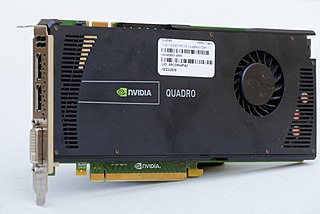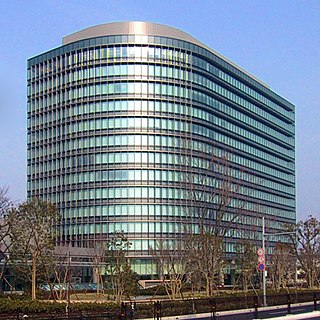GeForce is a brand of graphics processing units (GPUs) designed by Nvidia. As of the GeForce 20 series, there have been fifteen iterations of the design. The first GeForce products were discrete GPUs designed for add-on graphics boards, intended for the high-margin PC gaming market, and later diversification of the product line covered all tiers of the PC graphics market, ranging from cost-sensitive GPUs integrated on motherboards, to mainstream add-in retail boards. Most recently, GeForce technology has been introduced into Nvidia's line of embedded application processors, designed for electronic handhelds and mobile handsets.

A graphics processing unit (GPU) is a specialized electronic circuit designed to rapidly manipulate and alter memory to accelerate the creation of images in a frame buffer intended for output to a display device. GPUs are used in embedded systems, mobile phones, personal computers, workstations, and game consoles. Modern GPUs are very efficient at manipulating computer graphics and image processing. Their highly parallel structure makes them more efficient than general-purpose CPUs for algorithms that process large blocks of data in parallel. In a personal computer, a GPU can be present on a video card or embedded on the motherboard. In certain CPUs, they are embedded on the CPU die.

Nvidia Quadro is Nvidia's brand for graphics cards intended for use in workstations running professional computer-aided design (CAD), computer-generated imagery (CGI), digital content creation (DCC) applications, scientific calculations and machine learning.

CUDA is a parallel computing platform and application programming interface (API) model created by Nvidia. It allows software developers and software engineers to use a CUDA-enabled graphics processing unit (GPU) for general purpose processing — an approach termed GPGPU. The CUDA platform is a software layer that gives direct access to the GPU's virtual instruction set and parallel computational elements, for the execution of compute kernels.

Tegra is a system on a chip (SoC) series developed by Nvidia for mobile devices such as smartphones, personal digital assistants, and mobile Internet devices. The Tegra integrates an ARM architecture central processing unit (CPU), graphics processing unit (GPU), northbridge, southbridge, and memory controller onto one package. Early Tegra SoCs are designed as efficient multimedia processors, while more recent models emphasize performance for gaming and machine learning applications, without sacrificing power efficiency.
Project Denver is the codename of a microarchitecture designed by Nvidia that implements the ARMv8-A 64/32-bit instruction sets using a combination of simple hardware decoder and software-based binary translation where "Denver's binary translation layer runs in software, at a lower level than the operating system, and stores commonly accessed, already optimized code sequences in a 128 MB cache stored in main memory". Denver is a very wide in-order superscalar pipeline. Its design makes it suitable for integration with other SIPs cores into one die constituting a system on a chip (SoC).

Nvidia Tesla is Nvidia's brand name for their products targeting stream processing or general-purpose graphics processing units (GPGPU). Products use GPUs from the G80 series onward. The underlying Tesla microarchitecture of the GPUs and the Tesla product line are named after pioneering electrical engineer Nikola Tesla.
NVLink is a wire-based communications protocol serial multi-lane near-range communication link developed by Nvidia. Unlike PCI Express, a device can consist of multiple NVLinks, and devices use mesh networking to communicate instead of a central Hub.
Volta, an Nvidia-developed GPU microarchitecture codename, succeeds Pascal. It was first announced as a future roadmap ambition in March 2013. However the first product was not announced until May 2017. The architecture is named after Alessandro Volta. It was NVIDIA's first chip to feature Tensor cores, specially designed cores that have superior deep learning performance over regular CUDA cores.
An AI accelerator is a class of microprocessor or computer system designed as hardware acceleration for artificial intelligence applications, especially artificial neural networks, machine vision and machine learning. Typical applications include algorithms for robotics, internet of things and other data-intensive or sensor-driven tasks. They are often manycore designs and generally focus on low-precision arithmetic, novel dataflow architectures or in-memory computing capability. A number of vendor-specific terms exist for devices in this category, and it is an emerging technology without a dominant design. AI accelerators can be found in many devices such as smartphones, tablets, and computers all around the world. See the heading titled ¨Examples" for more examples.
Nvidia DGX-1 is a line of Nvidia produced servers and workstations which specialize in using GPGPU to accelerate deep learning applications. The servers feature 8 GPUs based on the Pascal or Volta daughter cards with HBM 2 memory, connected by an NVLink mesh network.

Tesla Autopilot also known as Enhanced Autopilot after a second hardware version started to be shipped, is an advanced driver-assistance system feature offered by Tesla that has lane centering, adaptive cruise control, self-parking, ability to automatically change lanes with driver confirmation, and enables the car to be summoned to and from a garage or parking spot.
Vibrante is the name of a Linux distribution created by NVIDIA and used for at least their Drive PX 2 platform series. The name is listed as a registered trademark of NVIDIA. First appearances of the name were seen in about the year 2010 when it labeled some rather universal multimedia engine including audio, video and 3D building display that was in tight cooperation with Audi company. At NVidia TechDay in December 2015 the distribution was reported with version numbers 3.0 for Jetson TK1 Pro and Drive CX, and with version 4.0 for Drive CX and PX platforms. Jetson TK1 is mentioned as running with the Linux4Tegra package instead. Companies like Toradex have built and published e.g. sample application codes on top of it. Abbreviations of Vibrante Linux like V3L, V3Le or V4L with the number representing the version plus terms like L4T and assigned to certain devices can be found in some history and release docs, e.g. for NVIDIA VisionWorks. On top of Vibrante it is possible to run NVIDIAs VisionWorks Toolkit. Vibrante is one of the targets that OpenCV4Tegra can run upon. Further there is the NVIDIA PerfKit Package that copes with Vibrante.
Nvidia Jetson is a series of embedded computing boards from Nvidia. The Jetson TK1, TX1 and TX2 models all carry a Tegra processor from Nvidia that integrates an ARM architecture central processing unit (CPU). Jetson is a low-power system and is especially designed for accelerating machine learning applications.

Kar-go is an autonomous delivery vehicle, designed and built by the Academy of Robotics, a UK company registered in Wales. The vehicle uses self-drive/driverless car technology to drive itself to locations where it will deliver packages autonomously.
Sierra or ATS-2 is a supercomputer built for the Lawrence Livermore National Laboratory for use by the National Nuclear Security Administration as the second Advanced Technology System. It is primarily used for predictive applications in stockpile stewardship, helping to assure the safety, reliability and effectiveness of the United States' nuclear weapons.
AImotive is an autonomous vehicle technology company working towards Level 5 autonomous vehicles. The company describes its approach as "vision-first", a system that primarily relies on cameras and artificial intelligence to detect its surroundings. The technology is designed to be implemented by automobile manufacturers to create fully autonomous vehicles, which can operate in all conditions and locations. In September 2017, PSA Group teamed up with AImotive.
Turing is the codename for a graphics processing unit (GPU) microarchitecture developed by Nvidia as the successor to the Volta architecture. It is named after the prominent mathematician and computer scientist, Alan Turing. The architecture was first introduced in August 2018 at SIGGRAPH 2018 along with professional workstation Quadro RTX products based on it and one week later at Gamescom along with consumer GeForce RTX products based on it. The architecture introduces the first consumer products capable of real-time raytracing, which has been a longstanding goal of the computer graphics industry. Key elements include dedicated artificial intelligence processors and dedicated ray-tracing processors. Turing leverages Microsoft's DXR, OptiX and Vulkan for access to ray-tracing. In February 2019, Nvidia released the GeForce 16 series of GPUs which utilize the new Turing design which, lacking the ray tracing and artificial intelligence cores, provides a lower cost alternative to the 20 series.














